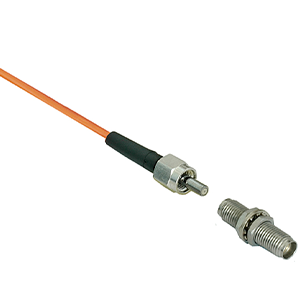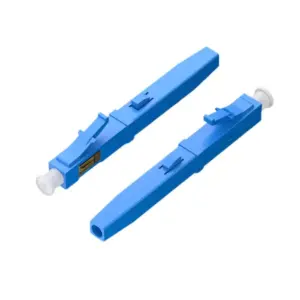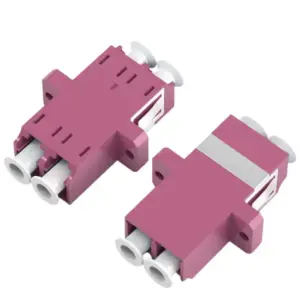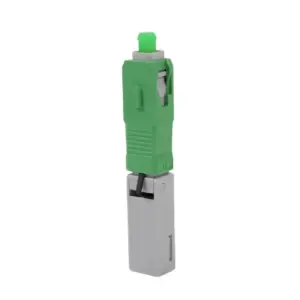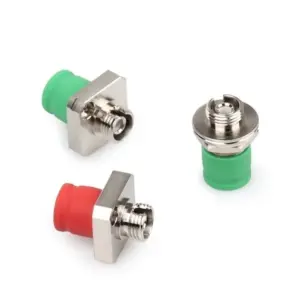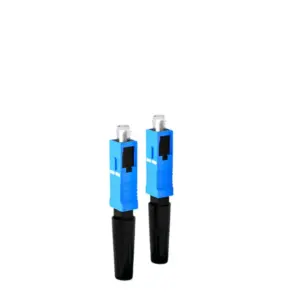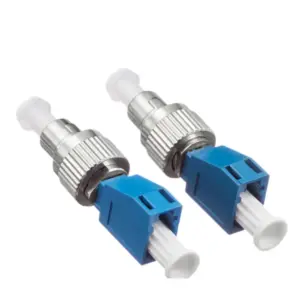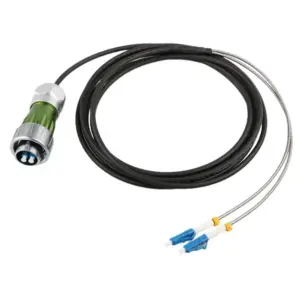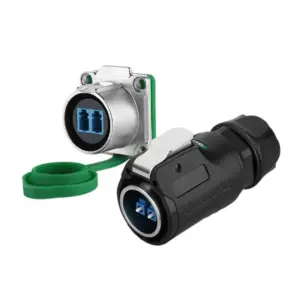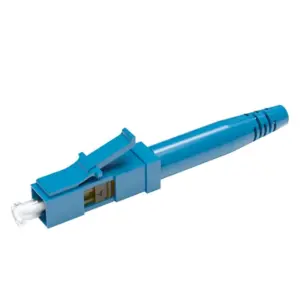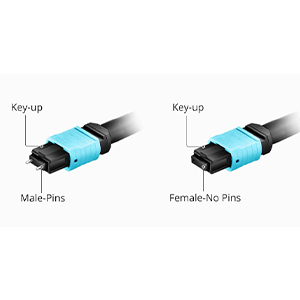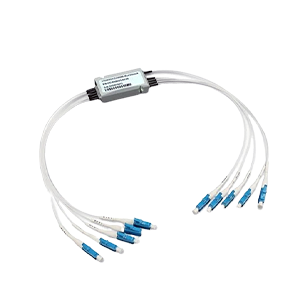Hello everyone! I believe you must have some understanding of the important position of SMA fiber connector in optical fiber communication network. As a connection method with a long history and wide application, SMA fiber connector is widely favored in fields such as industrial control and military communications due to its excellent optical performance and structural reliability. Today I am very happy to provide you with an in-depth analysis of the technical characteristics, main types and correct installation and maintenance methods of SMA connectors. By fully grasping the advantages of sma fiber connector, I believe you will be able to choose the best solution for your optical fiber network and further improve the overall transmission reliability and operational stability.
Overview of SMA fiber optic connectors
Let me give you an overview of SMA fiber optic connectors:
Definition and development history of SMA optical fiber connector:
- SMA is the abbreviation of “SubMiniature version A”, which refers to a small optical fiber connector.
- The SMA connector was first developed in the 1960s and was one of the connectors commonly used in early optical fiber communications.
- It adopts threaded connection, has a simple and compact structure, and is widely used in a variety of optical fiber equipment.
The role of SMA connectors in optical fiber networks:
- Provide reliable connections between optical fibers to ensure smooth transmission of optical signals.
- Supports quick connection and removal of optical fiber equipment to improve network flexibility.
- As a common standard interface in optical fiber networks, it promotes the compatibility of different devices.
Main features and advantages of SMA connectors:
- Simple and compact structure, easy to install and maintain.
- The connection is stable and reliable, suitable for various fiber types.
- Can withstand certain mechanical vibration and environmental pressure.
- The optical signal transmission performance is good and meets the needs of most applications.
- Relatively low cost, widely used, and suitable for various types of optical fiber networks.
SMA fiber optic connector is a commonly used connection method in early optical networks. While providing reliable connection between fiber optic devices, it also has the advantages of simple structure, easy installation, and good performance. Although more advanced optical fiber connection technologies have emerged over time, SMA connectors are still widely used in various optical fiber networks and play an important role.
Technical characteristics of SMA fiber optic connector
Let me introduce to you in detail the technical characteristics of the SMA fiber optic connector, as well as its differences and advantages compared with other connectors:
Physical structure and material composition of SMA connector:
- Shell material: usually made of metal, such as brass or stainless steel, which provides good mechanical strength.
- Interface structure: Threaded connection is used, which is highly reliable and easy to install and disassemble quickly.
- Optical fiber interface: Using precision ground ceramic ferrule to ensure the flatness of the fiber end face.
- Package structure: Sealed design, dustproof and moisture-proof, protecting internal optical components.
Optical, mechanical and electrical properties of SMA connectors:
Optical performance: Optical signal transmission loss is low, usually less than 0.5dB. The fiber alignment accuracy is high, which is conducive to the effective coupling of optical signals. It has average resistance to optical power damage and is suitable for low-power optical signal transmission.
Mechanical properties: It can withstand certain mechanical vibration and impact loads, and is suitable for general environmental applications. The connection has good stability and can provide reliable optical signal transmission. Long service life, usually up to more than 1000 connections/disconnects.
Electrical performance: It can effectively isolate electromagnetic interference and reduce the impact on optical signals. The small size is conducive to the integration and miniaturization design of optoelectronic equipment. The cost is relatively low and suitable for various fiber optic network applications.
The differences and advantages of SMA connectors compared to other types:
- Compared with FC, SC and other connectors, the SMA interface structure is simpler and more compact.
- Compared with large-diameter ST connectors, SMA has smaller size and weight.
- Compared with high-density connectors such as LC and MTP/MPO, the SMA interface is relatively large.
- In general, SMA is widely used in various optical fiber networks due to its balance of performance and cost.
To sum up, SMA fiber optic connectors have good optical transmission performance, reliable mechanical properties, and relatively low cost advantages. These characteristics made them widely used in early fiber optic networks and are still a popular choice today. Important fiber optic interface standard.
Main types of SMA fiber optic connectors
Let me introduce to you the main types of SMA fiber optic connectors and their differences in applicable scenarios and performance indicators:
SMA 905 and SMA 906 connectors:
- SMA 905 is the earliest and most common SMA connector type.
- SMA 906 is an improved version of SMA 905 with higher alignment accuracy.
- There are slight differences between the two in terms of appearance size, optical performance, working environment, etc.
Comparison of differences between various types of SMA connectors:
Applicable scenarios: SMA 905 is suitable for general optical fiber communication applications. SMA 906 is more suitable for optical systems that require high-precision alignment.
Optical performance: The optical signal transmission loss and return loss of SMA 906 are slightly better than SMA 905. SMA 906 provides higher fiber alignment accuracy and repeatability.
Working environment: SMA 905 has relatively loose requirements for environmental conditions. SMA 906 has stricter requirements on environmental factors such as temperature and humidity.
The application value of different SMA connectors in optical fiber networks:
- SMA 905 is widely used in general optical fiber communications and optoelectronic equipment.
- SMA 906 is more suitable for professional optical systems that require high optical transmission performance.
- Both have their own advantages in cost, reliability, scope of application, etc.
- Depending on specific application requirements, it is critical to select the appropriate SMA connector.
In short, SMA 905 and SMA 906 are the two main types of SMA connectors, and there are certain differences in applicable scenarios, optical performance and working environment. Optical fiber network engineers need to select the most appropriate SMA connector type based on actual application requirements to ensure the stable operation and reliability of the optical fiber network.
Installation and maintenance of SMA fiber optic connector
Let me introduce to you in detail the correct installation process, daily maintenance methods and common fault troubleshooting measures for SMA optical fiber connectors:
Correct installation process and precautions for SMA connectors:
- Carefully check the cleanliness of the connector and fiber end face and clean if necessary.
- Slowly insert the optical fiber into the connector jack, making sure it is fully seated and tighten the nut.
- Be careful not to apply excessive force during the connection process to avoid damaging the connector or optical fiber.
- After the installation is completed, check whether the connection is firm and test the optical signal transmission.
Daily maintenance and inspection methods of SMA connectors:
- Regularly check the appearance of the connector to ensure there is no damage, contamination or corrosion.
- Clean connectors and fiber end faces when appropriate to prevent dust and oil from accumulating.
- Check whether the connection is firm and whether the nut is loose.
- Replace damaged connectors or optical fibers when necessary to ensure transmission performance.
Common faults of SMA connectors and their troubleshooting measures:
- Fault phenomenon: Optical signal transmission loss is too high.
Check whether the connection is firm and whether the fiber end face is clean.
Measure the optical power to confirm whether there is a large optical coupling loss.
Replace the connector or re-clean the fiber end face and test again.
- Fault phenomenon: unstable connection, signal interruption
Check the connector nut for looseness or damage.
Confirm whether the alignment accuracy of the fiber end face and the connector jack meets the requirements.
Replace damaged connectors or optical fibers, reinstall and check.
- Fault phenomenon: The appearance of the connector is damaged
Replace damaged connectors promptly to ensure the reliability of fiber optic connections.
Analyze the cause of the damage and take measures to avoid similar problems from happening again.
If necessary, consider using a more rugged connector type.
Therefore, it is very important to correctly install and regularly maintain SMA fiber optic connectors, which can effectively prevent and eliminate common faults and ensure the stable operation of the fiber optic network. At the same time, it is also critical to select the appropriate SMA connector type according to actual application requirements.
Application of SMA fiber optic connectors in fiber optic networks
Let me introduce to you the typical applications of SMA fiber optic connectors in different fiber optic network application scenarios, and its importance in ensuring the reliability of optical signal transmission:
Application of SMA connectors in industrial control field:
- Industrial automation and process control systems make extensive use of fiber optic communications technology.
- SMA connectors are widely used in industrial sites due to their compact structure and easy installation.
- In harsh industrial environments, SMA connectors can provide reliable optical signal transmission.
Application of SMA connectors in military communications:
- Military communication systems have high requirements for reliability and anti-interference.
- SMA connectors are widely used in military communications due to their excellent anti-interference performance.
- In scenarios that require frequent disassembly and assembly, the reliability and durability of SMA connectors are reflected.
Applications of SMA connectors in aerospace:
- Aerospace equipment has strict weight and volume restrictions.
- SMA connectors are small in size and light in weight, making them very suitable for the integration of aerospace equipment.
- In high-vibration environments, SMA connectors can reliably transmit optical signals.
The importance of SMA connectors in ensuring the reliability of optical signal transmission:
- The reliability of fiber optic networks depends largely on the performance of the connectors.
- SMA connectors have good optical transmission characteristics and mechanical reliability.
- In harsh environments, SMA connectors can continuously and stably provide optical signal transmission services.
- This makes it the preferred fiber optic connection method for industrial control, military communications, aerospace and other fields.
In short, SMA fiber optic connectors are widely used in various fiber optic network scenarios such as industrial control, military communications, aerospace, etc. due to their compactness, durability, and reliability. It plays an important role in ensuring the reliability of optical signal transmission and is one of the key components of optical fiber networks in these fields.
Summary
SMA optical fiber connectors are undoubtedly the best choice in the construction of optical fiber communication networks. Its excellent optical performance, structural reliability and wide range of applications all highlight the outstanding status of SMA connectors. Whether it is industrial control, military communications or other fields, SMA connectors can inject powerful power into your fiber optic network to ensure the reliability and stability of signal transmission.
We provide professional fiber optic connector products and installation and maintenance services, and are equipped with an experienced technical team to provide you with considerate guidance at any time. If you have any questions about choosing or using SMA fiber connector, please feel free to contact us for communication.
sma fiber connector FAQ
SMA (Subminiature Version A) fiber connectors are a type of fiber optic connector used to terminate and connect single-mode or multimode optical fibers. They feature a threaded coupling mechanism.
SMA connectors have a small, cylindrical design with a 0.935 mm (0.368 inch) diameter body. They provide a secure and repeatable connection with their threaded coupling, and are known for their durability and simplicity.
SMA connectors are widely used in a variety of fiber optic applications, including test and measurement equipment, industrial automation, medical devices, and some telecommunications systems.
Unlike some other connector types, such as FC or SC, SMA connectors do not have a keying feature to ensure proper alignment. They rely on the threaded connection to maintain the proper orientation.
Advantages include simplicity, ruggedness, and low cost. Disadvantages include the lack of a keying feature, which can make alignment more challenging, and relatively higher insertion loss compared to some other connector types.
SMA connectors typically require careful cleaving, stripping, and polishing of the fiber end face to ensure proper termination. Specialized tools and techniques are used to properly attach the connector to the fiber.
Key specifications include insertion loss, return loss, and repeatability, which can vary depending on the specific connector style and application requirements.
Yes, there are various SMA connector styles, including SMA 905 (for multimode fibers) and SMA 906 (for single-mode fibers), which differ slightly in their physical dimensions and performance characteristics.
Proper cleaning techniques, such as the use of lint-free wipes and alcohol, are essential to remove contamination and ensure optimal performance of SMA connectors.
While SMA connectors can be adapted to interface with other connector types, such as FC or ST, using adapters, it is generally recommended to use the same connector type throughout a fiber optic system for optimal performance and compatibility.

